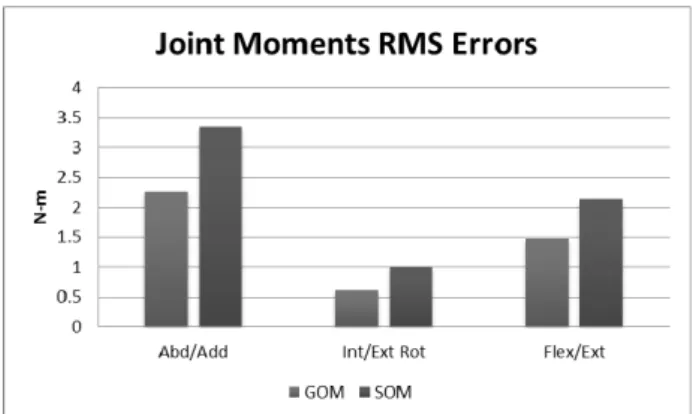Using global optimization method to compensate soft tissue artifacts
on knee joint angles and moments calculation during cycling
應用全域最佳化方法補償腳踏車踩踏過程因皮膚移動造成計算膝關節
角度與關節力矩之誤差
NSC (101-2627-B-002-007-) 101/08/01 ~ 102/10/31
Jia-Da Li1, Cheng-Chung Lin1, Yu-Huan Wu1, Tsung-Chi Lin1, Mei-Ying Kuo3, Horng-Chaung Hsu4,
Tung-Wu Lu1,2,*
1 Institute of Biomedical Engineering, National Taiwan University, Taipei, Taiwan 2 Department of Orthopaedic Surgery, School of Medicine, National Taiwan University, Taiwan
3 School of Physical Therapy, China Medical University, Taiwan 4 Department of Orthopedics, China Medical University Hospital, Taiwan
* Email: twlu@ntu.edu.tw Abstract- Soft tissue artifacts (STA) are a major
source of errors in human motion analysis. The Global Optimization Method (GOM) is effective in compensating STA during gait, but its performance has not been reported during cycling. Five young adults performed cycling exercises on an ergometer. A CT-to-biplane fluoroscopy registration technique is taken as the gold standard. A model composed of the pelvis, thigh and shank was used to calculate the angles and moments at the knee from the skin markers, without considering STA and with GOM to compensate for STA. The results showed that the GOM was effective in compensating the STA of the markers for the calculation of the angles and moments at the knee during cycling movement. 摘要- 皮膚移動是人體動作分析主要的誤差來 源之一。全域最佳化方法已被證實可有效補償步 態過程之皮膚移動誤差,然而針對腳踏車運動仍 未有相關之驗證結果。本研究以結合斷層掃描、 雙平面動態 X 光比對技術之結果做為標準,驗證 全域最佳化方法應用於腳踏車踩踏過程補償皮 膚移動誤差之功效。五位年輕正常受試者參與本 項研究,建構所需之下肢多連桿模型包含骨盆、 大腿與小腿。其結果比較傳統未考慮多肢段皮膚 移動誤差分析方法,顯示經由全域最佳化方法處 理後所計算之膝關節角度與關節力矩誤差均有 明顯降低。此方法證實可有效補償腳踏車運動過 程因皮膚移動所造成之誤差。
Introduction- Soft tissue artifacts (STA) are a major source of errors in human motion analysis, affecting the calculated joint angles and moments. The Global Optimization Method (GOM) is effective in compensating STA during gait [1] but its performance for activities involving large range of motion such as cycling has not been reported,
mainly owing to the difficulty in obtaining accurate skeletal motion noninvasively. This study evaluated the GOM using the skeletal motions of the knee measured by a 3D fluoroscopy technique during cycling.
Methods- Five young adults wearing 14 skin markers on the left lower limb performed cycling exercises on an ergometer (Fig. 1) while the pedal reaction forces were measured with an instrumented pedal and the trajectories by a motion capture system. The skeletal motions of the left knee were measured using a CT-to-biplane fluoroscopy registration technique [2] and then taken as the gold standard (Fig 2). A 3-link model composed of the pelvis, thigh and shank was used to calculate the angles and moments at the knee from the skin markers, without considering STA and with GOM to compensate for STA. The root-mean-squared errors (RMSE) of the calculated variables were then obtained with respect to the gold standard.
Fig. 1: The instrumented ergonometer integrated with the dynamic fluoroscopy system for cycling exercise
Fig. 2: The bone models obtained from CT scan were registered with fluoroscopic images during pedaling exercise for reproducing the kinematics of the knee.
Results & Discussion- The RMSE’s of the angles in the sagittal, transverse and frontal planes using GOM were 2.9, 3.8 and 9.3 degrees, respectively, compared to 9.1, 7.8 and 10.8 degrees without considering STA (Fig. 3). The corresponding values for joint moments were 1.5, 0.6 and 2.3 Nm for GOM, and 2.4, 1.1 and 3.3 Nm without considering STA (Fig. 4). The results showed that the GOM was effective in compensating the STA of the markers for the calculation of the angles and moments at the knee during cycling movement, which will be useful for future study of knee biomechanics during cycling using skin marker-based motion analysis.
Fig. 3: Root mean square errors of knee joint angles computed from global optimization method (blue bar) and segmental optimization method (red bar) during one cycle.
Fig. 4: Root mean square errors of knee joint
moments computed from global optimization method (blue bar) and segmental optimization method (red bar) during one cycle.
References
[1] Lu, T.W. and J.J. O’Connor (1999) J Biomech, 32: 129-134.
[2] Tsai, T.Y., et al. (2010) Med Phys, 37: 1273-1284.
